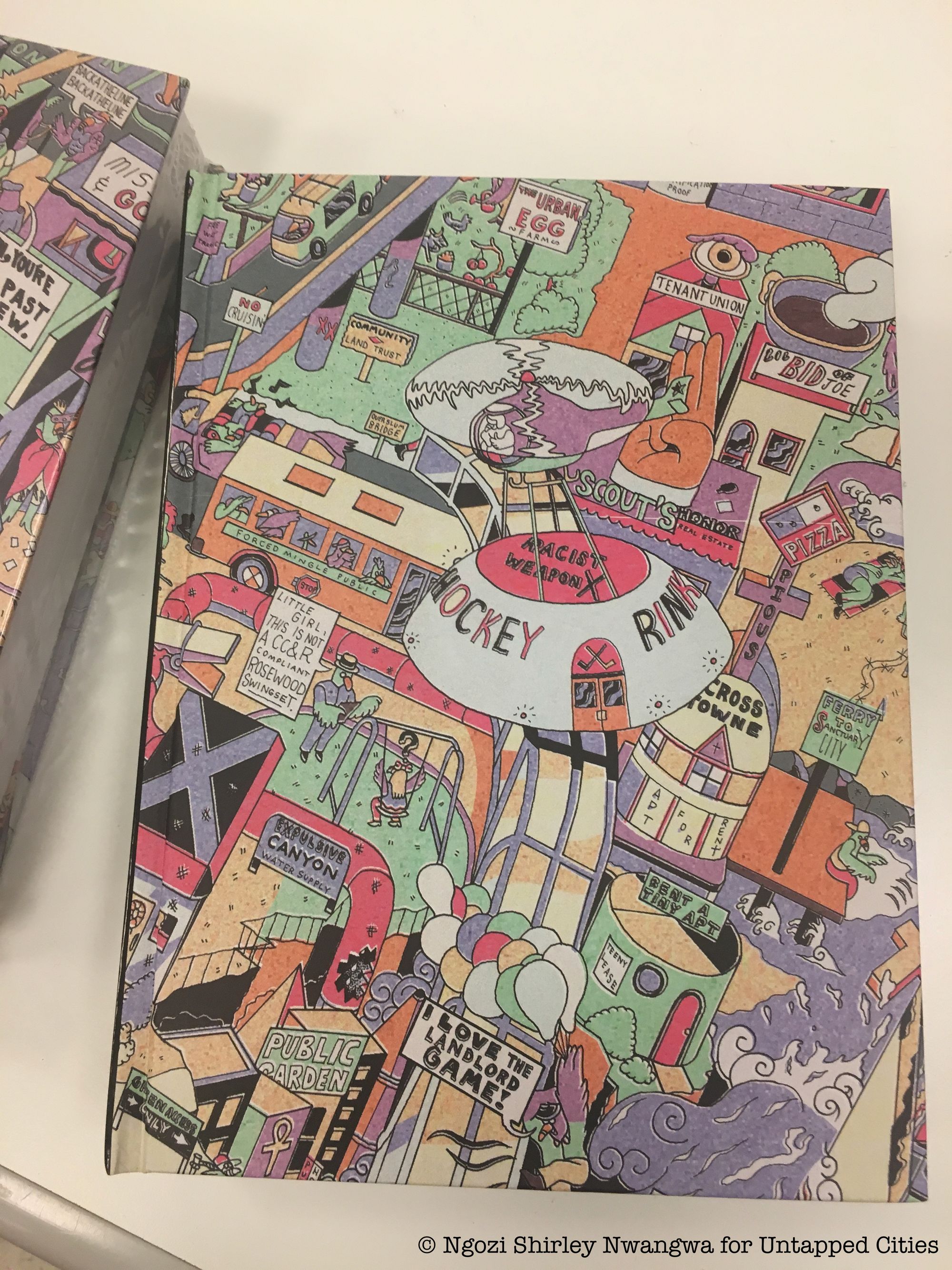Rediscovering WPA Poster Art of the National Parks with Ranger Doug
Join "Ranger of the Lost Art" Doug Leen for a virtual book talk about preserving the lost 1930s art of America's National Parks!



On January 26, the Center for Architecture hosted the opening of The Arsenal of Exclusion and Inclusion: New York Edition, an exhibition based on a book of the same name.
At one end of the exhibition room stands a mural that commands most of the wall behind it. From far off, the artwork looks to be a colorful, albeit cartoonish, replica of any metropolis, with its tall buildings, grid-like street pattern and teeming inhabitants. A closer inspection of the piece reveals the characters to be of an avian (yes, as in birds) race and the buildings and signage a fantasy, a product of an artist’s re-imagination of the New York City that needs reckoning with.
The illustrator of the book, the front and back cover of which you can recognize as sections of the mural, conceptualized the art to accompany its message. The purpose of The Arsenal of Exclusion & Inclusion, as it reads on the back cover, is to: “examine some of the policies, practices and physical artifacts that have been used by planners, policymakers, developers, real estate brokers, community activists and other urban actors in the United States to redraw the lines that divide. The Arsenal inventories these weapons of exclusion and inclusion, describes how they have been used, and speculates about how they might be deployed (or retired) for the sake of more open cities in which more people have access to more places.”
During opening night, the gallery space was packed with guests who were still bundled up in winter coats, hats and scarves — a showing of not only the season but also of the Center’s coat check at capacity. As folks scrambled for standing room among the din of chatter, we made our way to the night’s feature. In one corner of the street-level gallery was a room that was fully visible from the side walk outside, but on the inside, was only accessible to around 15 people, comfortably. The curators of the event, who also form the leadership team of Interboro, the architectural firm behind Arsenal, perhaps designed the exhibit with exclusionary and inclusionary elements in mind.

One of the main features of the exhibit, an array of brown benches, sits opposite of the mural. Tethered to the benches, which are similar to many that are found in New York City subway stations, are copies of The Arsenal of Exclusion & Inclusion. Pasted on the wall above the benches are cut-outs from the mural that the curators wanted to highlight. These pieces are accompanied by an excerpt from the book, which details the historical and legislative significance of the “weapon” that is pictured.
Arsenal, for example, lists decorative armrests, found on public benches, to be one such weapon. They are deterrents to another often marginalized group of people: those who are homeless. Strategically placed at the “midpoint of benches,” they make it extremely uncomfortable or impossible to sleep in public places.
The “policies, practices and physical artifacts” that the authors of The Arsenal — Tobias Armborst, Daniel D’Oca, Georgeen Theodore — detail in the book, are all referenced in Lesser Gonzalez’s illustration. At the exhibit (as well folded into the back cover of the book) the mural is set in a ruled grid, the horizontal sections marked 1-4, the vertical sections marked a-d.
“Jim Crow Laws,” listed on the mural’s “key” as found in section b2, leads a guest’s eyes to the depiction of a large bird, sporting what appears to be oxford shoes and an equally dapper, rimmed hat, drinking from a cucumber water fountain. Another, visibly smaller bird, wearing a backwards cap and unassuming shoes, stands puzzled in front of a separate, adjacent water fountain that would normally dispense “Ol’ Crow Tap Water.” Unfortunately, a “Broken” sign is leaning against this water fountain.

Modern legislation leaves no room for Jim Crow-era manifestations like drinking fountain segregation. However, Arsenal traces the history of racist blunders to recent lawmaking; for instance, the Neighborhood Order of Protection is a court order that “restricts criminal defendants from entering certain neighborhoods as a condition of their probation or bond.” In 2010, New York City police sergeant John McLaughlin pronounced his support for community members’ engagement with the database of Neighborhood Protection Orders. People can peruse the logs of protection orders, which include photos of defendants, and promote the efforts to keep urban spaces clear of unwanted individuals. Arsenal quotes McLaughlin as urging New Yorkers and others to help “pick these guys out quickly for us.”

Copies of The Arsenal book were on sale during opening night at the exhibit. When we asked J.A. Strub, a housing specialist who works in Queens, why they purchased the book on the spot, Strub answered, “The book takes topics and policies that people working in urban planning think about and concern themselves with everyday, and packages it in a way that is accessible to anyone.”
The Arsenal of Exclusion & Inclusion: New York Edition continues through March 31, 2018 at the Center for Architecture in Greenwich Village. Also, RSVP for the Oculus Book Talk: The Arsenal of Exclusion & Inclusion on Thursday, March 1st, 2018 from 6-8pm at the Center of Architecture.
Next, check out: A History of NYC Revealed in Mike Wallace’s Greater Gotham and try to catch these 19 Art Installations and Exhibits in NYC Not to Miss in February.
Shirley Ngozi Nwangwa is a Master’s Student in Journalism at NYU. Follow her on Twitter and Instagram @llovellin.
Subscribe to our newsletter